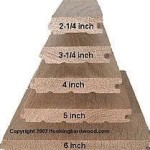How to Lay Laminate Flooring On Floorboards
Laying laminate flooring over existing floorboards is a popular and cost-effective way to update a room's appearance. Laminate offers durability, ease of maintenance, and a wide variety of styles to mimic hardwood, tile, or stone. Successfully installing laminate over floorboards requires careful preparation, attention to detail, and adherence to proper installation techniques. This article provides a comprehensive guide to laying laminate flooring on floorboards, ensuring a professional and long-lasting result.
Preparing the Existing Floorboards
Before installing any laminate flooring, thorough preparation of the existing floorboards is paramount. This stage determines the stability and longevity of the final product. Overlooking imperfections or inadequate preparation can lead to issues such as uneven surfaces, squeaking, and premature wear.
The first step involves a comprehensive inspection of the floorboards. Assess the floor for any signs of damage, including loose boards, warping, rot, and protruding nails or screws. Address these issues promptly to create a solid and level foundation. Loose boards should be securely fastened with screws, ensuring they are flush with the surrounding boards. Warped or severely damaged boards should be replaced entirely to prevent future problems. Rot, often caused by moisture, requires immediate attention. Identify the source of the moisture, rectify the problem, and treat the affected area with a wood preservative to prevent further deterioration.
Next, address any protruding nails or screws. Hammer nails below the surface of the floorboards using a nail set. This tool prevents damage to the surrounding wood. Countersink any screws that are sticking up. Failure to address these protrusions will create bumps under the laminate, leading to uneven flooring and potential damage to the laminate's locking mechanisms.
Leveling the floorboards is a critical step. Even minor variations in height can affect the final appearance and structural integrity of the laminate floor. Use a long straightedge and a level to identify any high or low spots. High spots can be sanded down using a belt sander or a floor sander. Take caution not to over-sand and create dips in the floor. Low spots can be filled with a floor-leveling compound. Follow the manufacturer's instructions for mixing and applying the leveling compound. Allow the compound to dry completely before proceeding. For more substantial variations in floor height, self-leveling compounds may be necessary. These compounds flow freely and create a perfectly level surface. Again, ensure the subfloor is clean and primed before applying the self-leveling compound.
Cleaning the floorboards is essential for ensuring proper adhesion of the underlayment. Sweep the floor thoroughly to remove any dust, debris, or loose particles. Vacuum the floor to remove any remaining fine particles. If necessary, scrub the floor with a mild detergent and water to remove any stubborn dirt or grime. Allow the floor to dry completely before proceeding. A clean surface promotes optimal adhesion and prevents the underlayment from shifting or bunching during installation.
Finally, check for any signs of movement in the floorboards. If the floorboards are excessively bouncy or flexible, it may indicate structural issues that need to be addressed before installing the laminate flooring. Consult a professional to assess the situation and recommend appropriate solutions. Adding additional support joists may be necessary to reinforce the floor structure.
Selecting and Installing the Underlayment
The underlayment is a crucial component of a laminate flooring installation. It provides a smooth, stable surface for the laminate planks, absorbs sound, adds insulation, and protects the laminate from moisture. Selecting the right underlayment and installing it correctly is essential for achieving a comfortable and long-lasting floor.
Consider the different types of underlayment available. Foam underlayment is a common and affordable option, providing basic cushioning and sound absorption. Cork underlayment is a more environmentally friendly choice, offering superior sound insulation, thermal insulation, and moisture resistance. Rubber underlayment is the most premium option, providing exceptional sound absorption, durability, and moisture protection. The choice of underlayment will depend on budget, desired performance characteristics, and specific needs of the project. For example, if sound reduction is a priority, a thicker, higher-density underlayment is recommended. If moisture is a concern, a moisture-resistant underlayment is essential.
Before installing the underlayment, measure the room and calculate the amount of underlayment needed. Purchase slightly more underlayment than required to account for waste and overlaps. Unroll the underlayment and allow it to acclimate to the room's temperature and humidity for at least 24 hours. This will help prevent expansion and contraction after installation.
Begin laying the underlayment along one wall, leaving a small gap (approximately ¼ inch) between the underlayment and the wall. This gap allows for expansion and contraction of the flooring materials. Use a utility knife to trim the underlayment to fit the room's dimensions. Overlap adjacent rows of underlayment by a few inches and secure the seams with underlayment tape. This prevents moisture from seeping through the seams and damaging the laminate flooring. Some underlayments come with self-adhesive strips for easy installation.
Pay close attention to the manufacturer's instructions for the specific type of underlayment being used. Some underlayments require a vapor barrier to be installed underneath, especially in basements or other areas with high moisture levels. A vapor barrier is a thin plastic sheet that prevents moisture from rising from the subfloor and affecting the laminate flooring. Overlapping the seams of the vapor barrier by several inches and sealing them with tape is crucial for creating an effective moisture barrier.
Inspect the installed underlayment carefully. Ensure that it is flat, smooth, and free of wrinkles or bumps. Any imperfections in the underlayment can affect the final appearance and performance of the laminate flooring. If necessary, smooth out any wrinkles or bumps with a utility knife or by adding additional tape.
Installing the Laminate Flooring
With the floorboards properly prepared and the underlayment installed, the final step is to lay the laminate flooring. This process involves careful planning, precise cutting, and secure locking of the laminate planks.
Begin by planning the layout of the laminate flooring. Determine the direction in which the planks will be laid. Generally, it is recommended to lay the planks parallel to the longest wall in the room to create a more spacious appearance. Consider the placement of doorways, hallways, and other architectural features. Staggering the end joints of the planks creates a more visually appealing and structurally sound floor. Avoid creating seams that line up directly with each other.
Before starting the installation, allow the laminate planks to acclimate to the room's temperature and humidity for at least 48 hours. This helps them to expand or contract to their natural size, preventing gaps or buckling after installation. Store the planks in the room where they will be installed, laying them flat and allowing air to circulate around them.
Begin laying the first row of planks along one wall, leaving a ¼-inch expansion gap between the planks and the wall. Use spacers to maintain a consistent gap. The expansion gap allows the flooring to expand and contract with changes in temperature and humidity without buckling or warping. Many laminate flooring manufacturers sell specific spacers for this purpose.
Use a tapping block and a rubber mallet to gently tap the planks together, ensuring a tight and secure fit. The tapping block protects the edges of the planks from damage during installation. Work row by row, staggering the end joints of the planks. Cut the planks to size using a saw, ensuring clean and precise cuts. A laminate flooring cutter can also be used for straight cuts, providing a cleaner and faster alternative to a saw.
When installing planks around doorways, pipes, or other obstacles, use a jigsaw or a coping saw to make precise cuts. Measure the space accurately and transfer the measurements onto the plank. Cut along the marked lines carefully, ensuring a snug fit around the obstacle. Use caulk or sealant to fill any gaps around pipes or other fixtures, preventing moisture from seeping underneath the flooring.
For the final row of planks, it may be necessary to rip the planks to width using a table saw or a circular saw. Measure the distance between the last row of planks and the wall, and subtract the ¼-inch expansion gap. Cut the planks to the correct width and install them using a pull bar and a tapping block. The pull bar helps to pull the planks into place when there is not enough room to use a tapping block.
Remove the spacers and install baseboards or quarter-round molding around the perimeter of the room. The baseboards or molding cover the expansion gap and provide a finished look. Nail or screw the baseboards or molding to the wall, not to the floor. This allows the flooring to move freely without being restricted by the baseboards or molding.
Clean the newly installed laminate flooring with a damp cloth or mop. Avoid using excessive amounts of water, as this can damage the flooring. Use a cleaner specifically designed for laminate flooring to remove any dirt or stains. Ensure to follow the manufacturer's care and maintenance instructions to prolong the life and beauty of the laminate floor.

A Guide To Fitting Wood And Laminate Flooring Expert Advice Floorsave

How To Install Laminate Flooring For Beginners

Laying New Wood Flooring Over Original Uneven Floorboards Le Arthur Wells

Determining The Direction To Lay Install Hardwood Laminate Or Luxury Vinyl Plank Flooring

How To Lay Laminate Flooring Cost In Fantastic Handyman

Common Mistakes When Laying Laminate Flooring Next Day Floors

How To Lay Laminate Flooring Laying Wickes

Can I Lay Laminate Flooring Over Floorboards The Guys

Hybrid Timber Laminate Flooring Installation Comprehensive Guide

The Ultimate Guide To Installing Laminate Flooring Parrys
Related Posts








